Chronic Obstructive Pulmonary Disease - PDF
VerifiedAdded on 2021/06/17
|10
|2118
|34
AI Summary
Contribute Materials
Your contribution can guide someone’s learning journey. Share your
documents today.
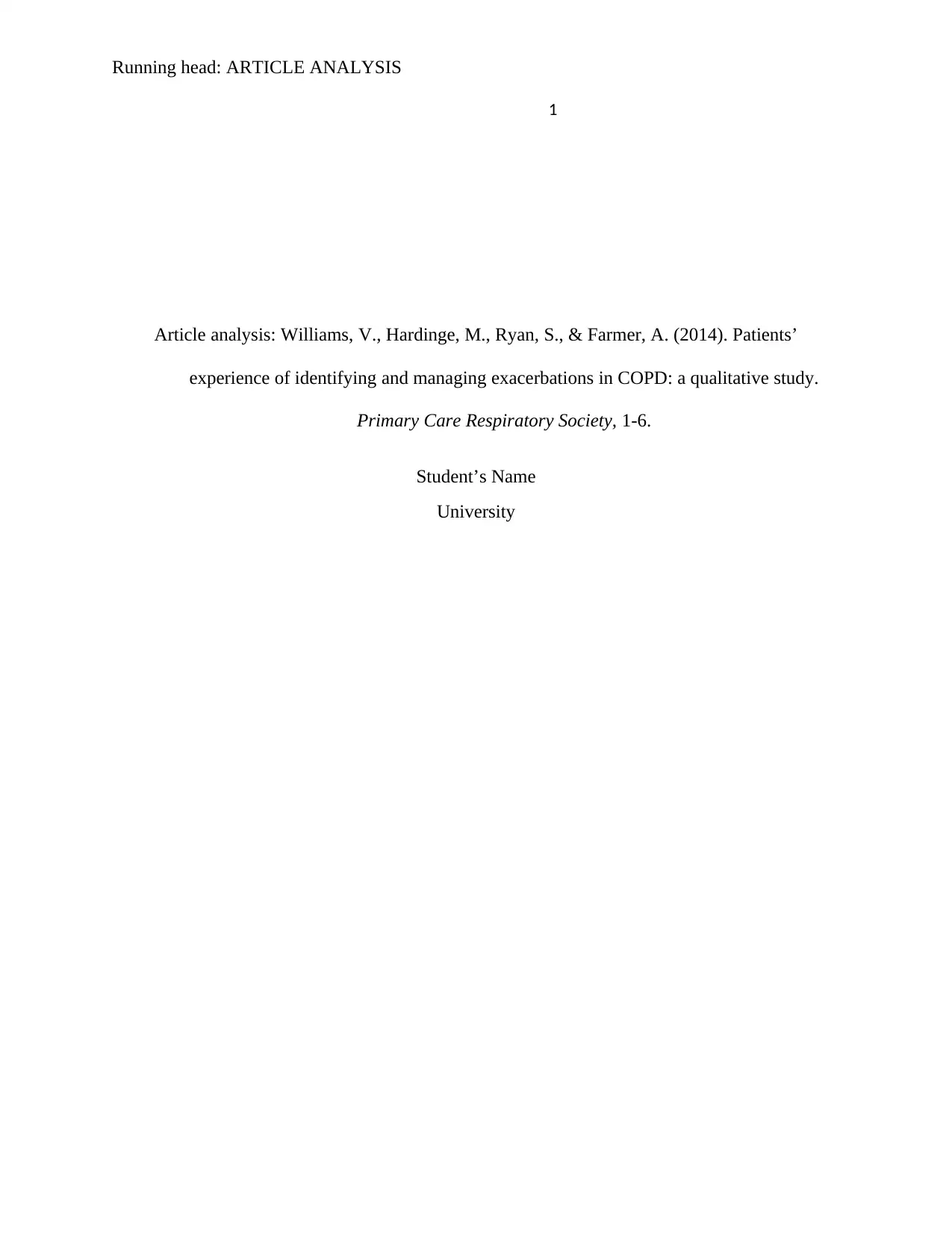
Running head: ARTICLE ANALYSIS
1
Article analysis: Williams, V., Hardinge, M., Ryan, S., & Farmer, A. (2014). Patients’
experience of identifying and managing exacerbations in COPD: a qualitative study.
Primary Care Respiratory Society, 1-6.
Student’s Name
University
1
Article analysis: Williams, V., Hardinge, M., Ryan, S., & Farmer, A. (2014). Patients’
experience of identifying and managing exacerbations in COPD: a qualitative study.
Primary Care Respiratory Society, 1-6.
Student’s Name
University
Secure Best Marks with AI Grader
Need help grading? Try our AI Grader for instant feedback on your assignments.
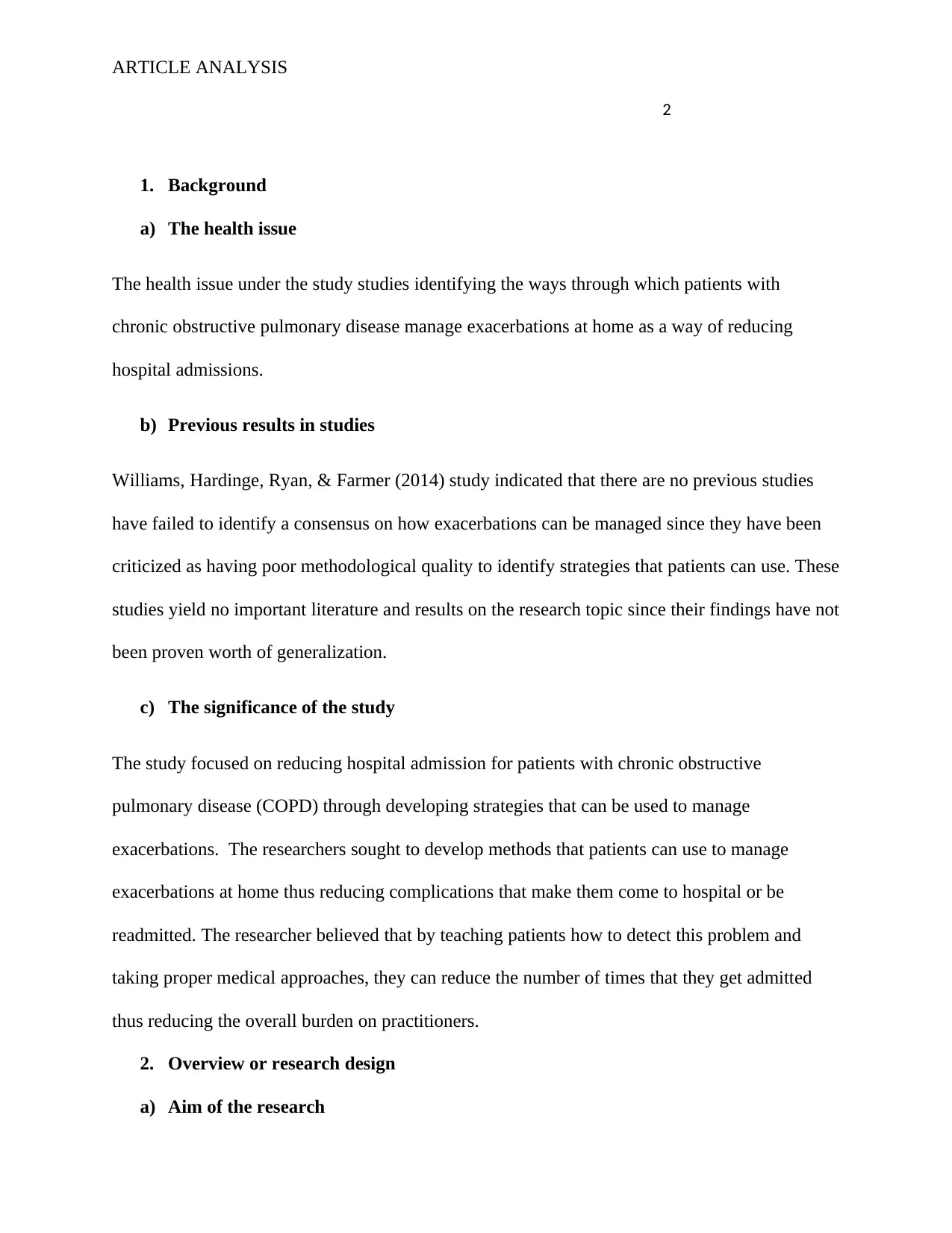
ARTICLE ANALYSIS
2
1. Background
a) The health issue
The health issue under the study studies identifying the ways through which patients with
chronic obstructive pulmonary disease manage exacerbations at home as a way of reducing
hospital admissions.
b) Previous results in studies
Williams, Hardinge, Ryan, & Farmer (2014) study indicated that there are no previous studies
have failed to identify a consensus on how exacerbations can be managed since they have been
criticized as having poor methodological quality to identify strategies that patients can use. These
studies yield no important literature and results on the research topic since their findings have not
been proven worth of generalization.
c) The significance of the study
The study focused on reducing hospital admission for patients with chronic obstructive
pulmonary disease (COPD) through developing strategies that can be used to manage
exacerbations. The researchers sought to develop methods that patients can use to manage
exacerbations at home thus reducing complications that make them come to hospital or be
readmitted. The researcher believed that by teaching patients how to detect this problem and
taking proper medical approaches, they can reduce the number of times that they get admitted
thus reducing the overall burden on practitioners.
2. Overview or research design
a) Aim of the research
2
1. Background
a) The health issue
The health issue under the study studies identifying the ways through which patients with
chronic obstructive pulmonary disease manage exacerbations at home as a way of reducing
hospital admissions.
b) Previous results in studies
Williams, Hardinge, Ryan, & Farmer (2014) study indicated that there are no previous studies
have failed to identify a consensus on how exacerbations can be managed since they have been
criticized as having poor methodological quality to identify strategies that patients can use. These
studies yield no important literature and results on the research topic since their findings have not
been proven worth of generalization.
c) The significance of the study
The study focused on reducing hospital admission for patients with chronic obstructive
pulmonary disease (COPD) through developing strategies that can be used to manage
exacerbations. The researchers sought to develop methods that patients can use to manage
exacerbations at home thus reducing complications that make them come to hospital or be
readmitted. The researcher believed that by teaching patients how to detect this problem and
taking proper medical approaches, they can reduce the number of times that they get admitted
thus reducing the overall burden on practitioners.
2. Overview or research design
a) Aim of the research
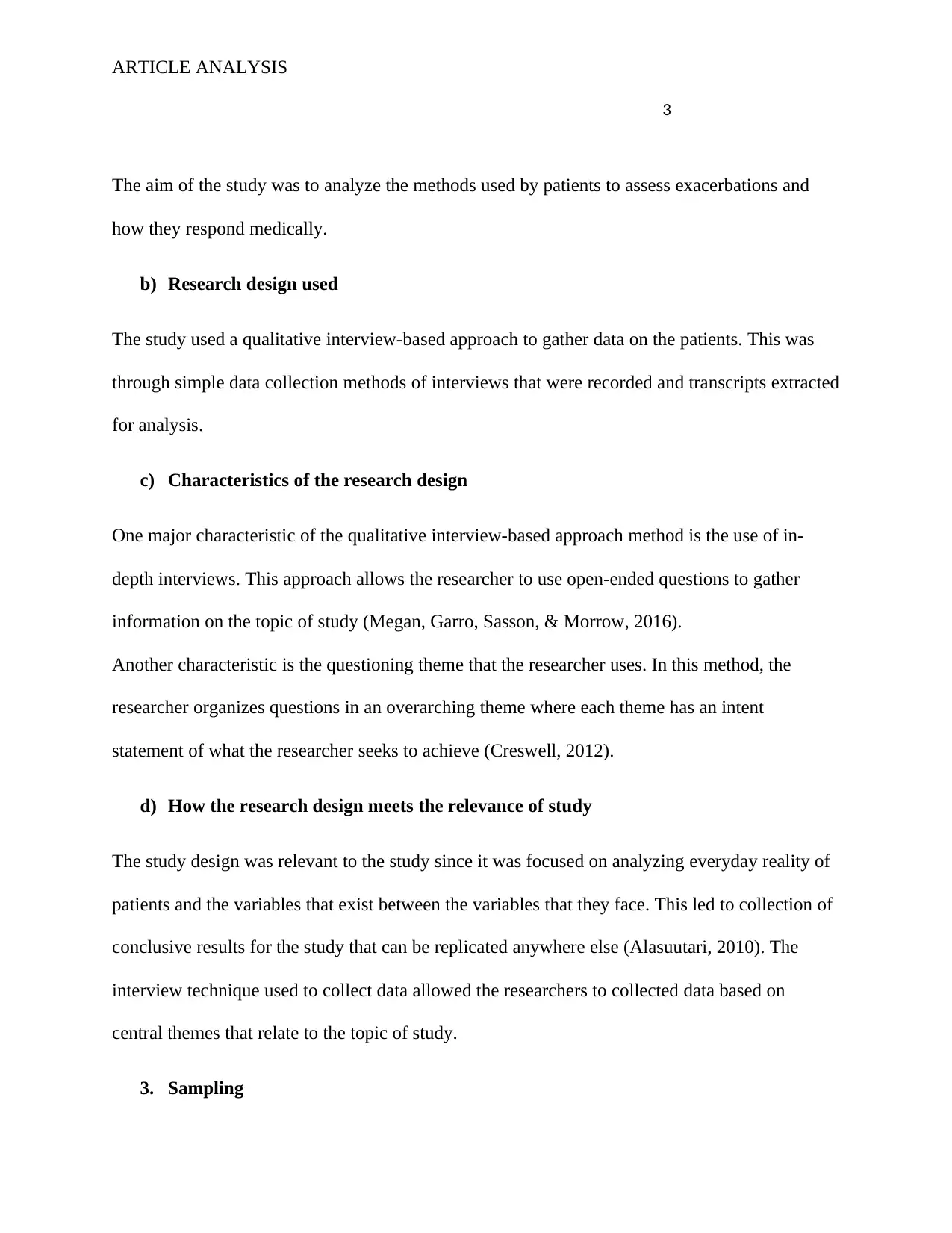
ARTICLE ANALYSIS
3
The aim of the study was to analyze the methods used by patients to assess exacerbations and
how they respond medically.
b) Research design used
The study used a qualitative interview-based approach to gather data on the patients. This was
through simple data collection methods of interviews that were recorded and transcripts extracted
for analysis.
c) Characteristics of the research design
One major characteristic of the qualitative interview-based approach method is the use of in-
depth interviews. This approach allows the researcher to use open-ended questions to gather
information on the topic of study (Megan, Garro, Sasson, & Morrow, 2016).
Another characteristic is the questioning theme that the researcher uses. In this method, the
researcher organizes questions in an overarching theme where each theme has an intent
statement of what the researcher seeks to achieve (Creswell, 2012).
d) How the research design meets the relevance of study
The study design was relevant to the study since it was focused on analyzing everyday reality of
patients and the variables that exist between the variables that they face. This led to collection of
conclusive results for the study that can be replicated anywhere else (Alasuutari, 2010). The
interview technique used to collect data allowed the researchers to collected data based on
central themes that relate to the topic of study.
3. Sampling
3
The aim of the study was to analyze the methods used by patients to assess exacerbations and
how they respond medically.
b) Research design used
The study used a qualitative interview-based approach to gather data on the patients. This was
through simple data collection methods of interviews that were recorded and transcripts extracted
for analysis.
c) Characteristics of the research design
One major characteristic of the qualitative interview-based approach method is the use of in-
depth interviews. This approach allows the researcher to use open-ended questions to gather
information on the topic of study (Megan, Garro, Sasson, & Morrow, 2016).
Another characteristic is the questioning theme that the researcher uses. In this method, the
researcher organizes questions in an overarching theme where each theme has an intent
statement of what the researcher seeks to achieve (Creswell, 2012).
d) How the research design meets the relevance of study
The study design was relevant to the study since it was focused on analyzing everyday reality of
patients and the variables that exist between the variables that they face. This led to collection of
conclusive results for the study that can be replicated anywhere else (Alasuutari, 2010). The
interview technique used to collect data allowed the researchers to collected data based on
central themes that relate to the topic of study.
3. Sampling
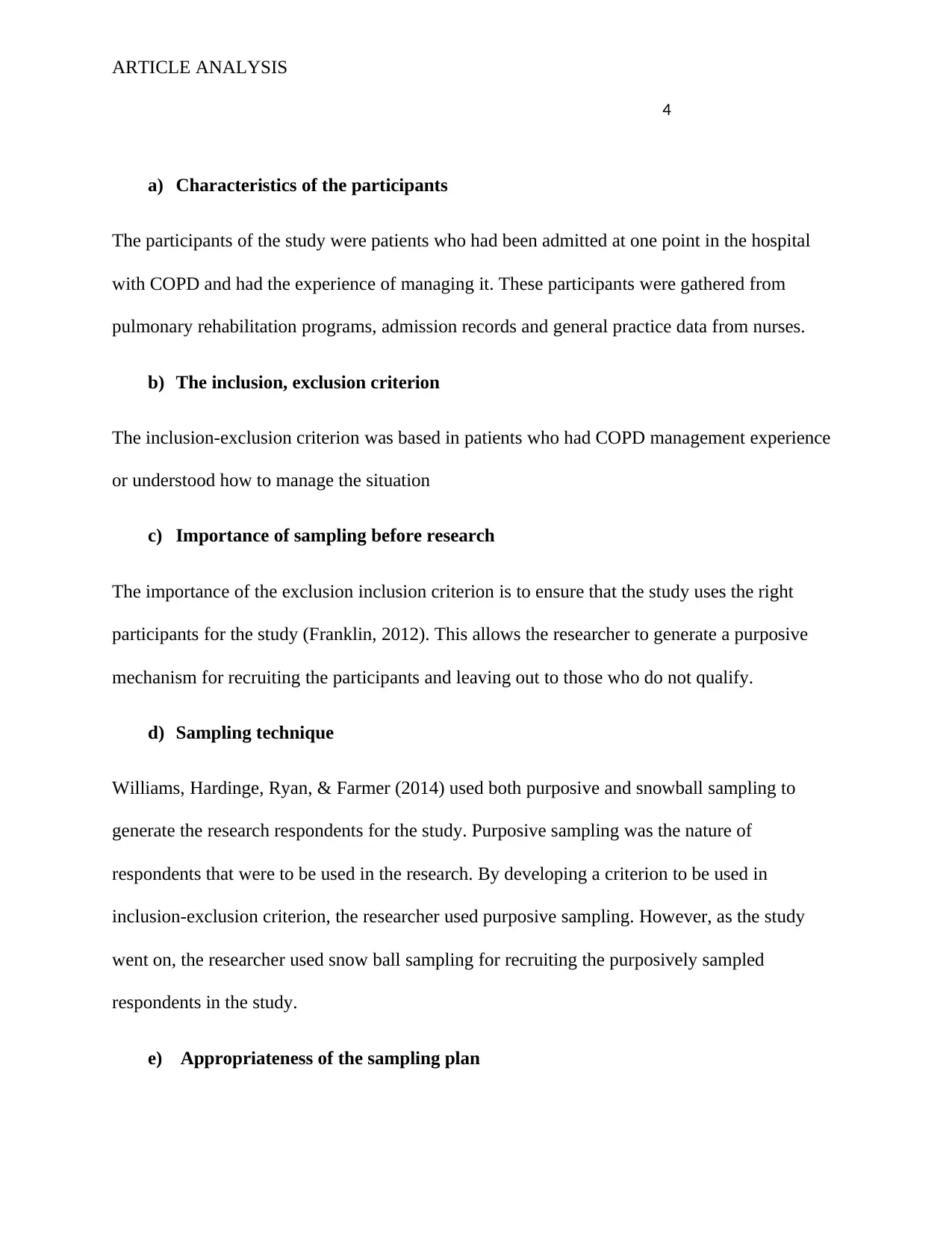
ARTICLE ANALYSIS
4
a) Characteristics of the participants
The participants of the study were patients who had been admitted at one point in the hospital
with COPD and had the experience of managing it. These participants were gathered from
pulmonary rehabilitation programs, admission records and general practice data from nurses.
b) The inclusion, exclusion criterion
The inclusion-exclusion criterion was based in patients who had COPD management experience
or understood how to manage the situation
c) Importance of sampling before research
The importance of the exclusion inclusion criterion is to ensure that the study uses the right
participants for the study (Franklin, 2012). This allows the researcher to generate a purposive
mechanism for recruiting the participants and leaving out to those who do not qualify.
d) Sampling technique
Williams, Hardinge, Ryan, & Farmer (2014) used both purposive and snowball sampling to
generate the research respondents for the study. Purposive sampling was the nature of
respondents that were to be used in the research. By developing a criterion to be used in
inclusion-exclusion criterion, the researcher used purposive sampling. However, as the study
went on, the researcher used snow ball sampling for recruiting the purposively sampled
respondents in the study.
e) Appropriateness of the sampling plan
4
a) Characteristics of the participants
The participants of the study were patients who had been admitted at one point in the hospital
with COPD and had the experience of managing it. These participants were gathered from
pulmonary rehabilitation programs, admission records and general practice data from nurses.
b) The inclusion, exclusion criterion
The inclusion-exclusion criterion was based in patients who had COPD management experience
or understood how to manage the situation
c) Importance of sampling before research
The importance of the exclusion inclusion criterion is to ensure that the study uses the right
participants for the study (Franklin, 2012). This allows the researcher to generate a purposive
mechanism for recruiting the participants and leaving out to those who do not qualify.
d) Sampling technique
Williams, Hardinge, Ryan, & Farmer (2014) used both purposive and snowball sampling to
generate the research respondents for the study. Purposive sampling was the nature of
respondents that were to be used in the research. By developing a criterion to be used in
inclusion-exclusion criterion, the researcher used purposive sampling. However, as the study
went on, the researcher used snow ball sampling for recruiting the purposively sampled
respondents in the study.
e) Appropriateness of the sampling plan
Secure Best Marks with AI Grader
Need help grading? Try our AI Grader for instant feedback on your assignments.
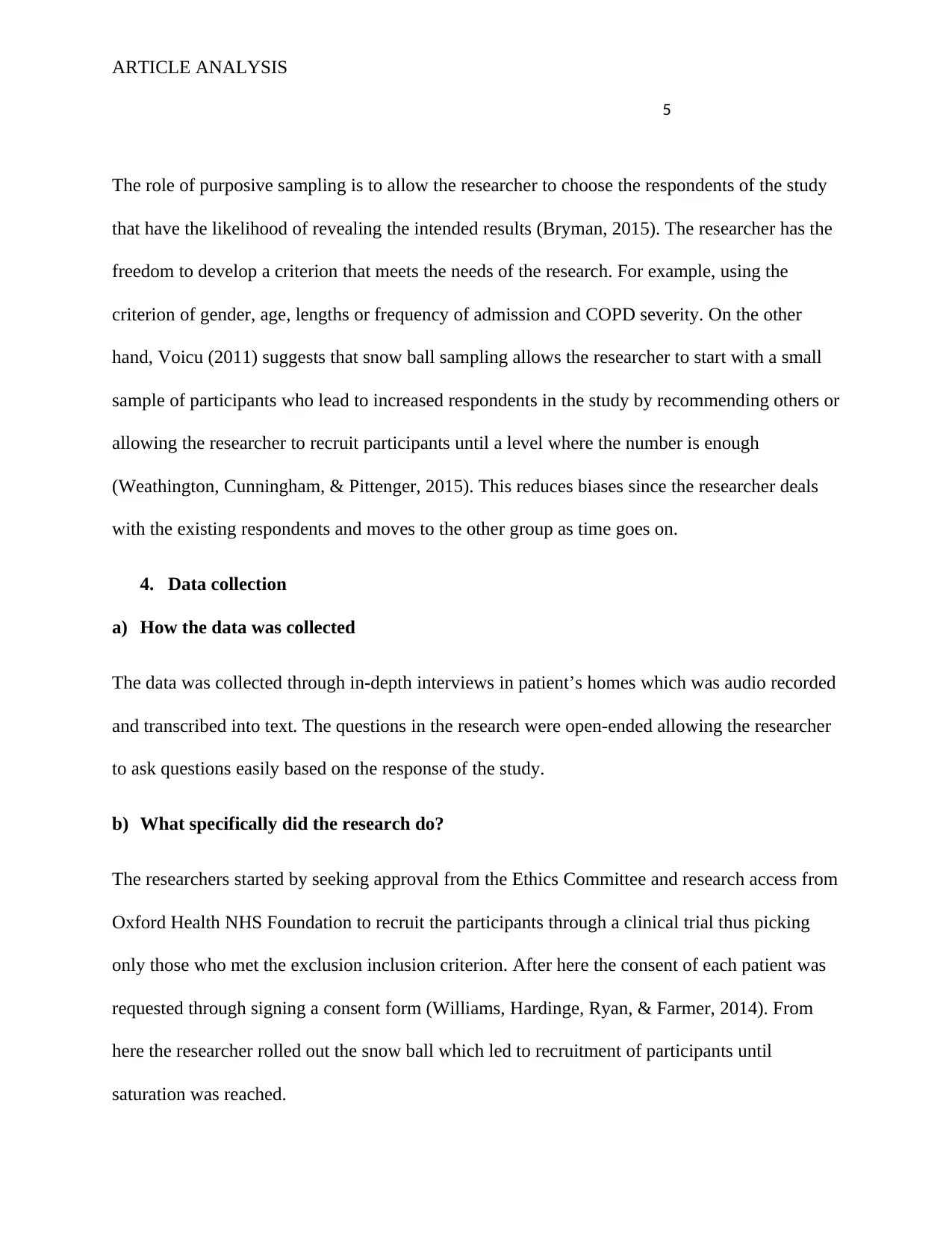
ARTICLE ANALYSIS
5
The role of purposive sampling is to allow the researcher to choose the respondents of the study
that have the likelihood of revealing the intended results (Bryman, 2015). The researcher has the
freedom to develop a criterion that meets the needs of the research. For example, using the
criterion of gender, age, lengths or frequency of admission and COPD severity. On the other
hand, Voicu (2011) suggests that snow ball sampling allows the researcher to start with a small
sample of participants who lead to increased respondents in the study by recommending others or
allowing the researcher to recruit participants until a level where the number is enough
(Weathington, Cunningham, & Pittenger, 2015). This reduces biases since the researcher deals
with the existing respondents and moves to the other group as time goes on.
4. Data collection
a) How the data was collected
The data was collected through in-depth interviews in patient’s homes which was audio recorded
and transcribed into text. The questions in the research were open-ended allowing the researcher
to ask questions easily based on the response of the study.
b) What specifically did the research do?
The researchers started by seeking approval from the Ethics Committee and research access from
Oxford Health NHS Foundation to recruit the participants through a clinical trial thus picking
only those who met the exclusion inclusion criterion. After here the consent of each patient was
requested through signing a consent form (Williams, Hardinge, Ryan, & Farmer, 2014). From
here the researcher rolled out the snow ball which led to recruitment of participants until
saturation was reached.
5
The role of purposive sampling is to allow the researcher to choose the respondents of the study
that have the likelihood of revealing the intended results (Bryman, 2015). The researcher has the
freedom to develop a criterion that meets the needs of the research. For example, using the
criterion of gender, age, lengths or frequency of admission and COPD severity. On the other
hand, Voicu (2011) suggests that snow ball sampling allows the researcher to start with a small
sample of participants who lead to increased respondents in the study by recommending others or
allowing the researcher to recruit participants until a level where the number is enough
(Weathington, Cunningham, & Pittenger, 2015). This reduces biases since the researcher deals
with the existing respondents and moves to the other group as time goes on.
4. Data collection
a) How the data was collected
The data was collected through in-depth interviews in patient’s homes which was audio recorded
and transcribed into text. The questions in the research were open-ended allowing the researcher
to ask questions easily based on the response of the study.
b) What specifically did the research do?
The researchers started by seeking approval from the Ethics Committee and research access from
Oxford Health NHS Foundation to recruit the participants through a clinical trial thus picking
only those who met the exclusion inclusion criterion. After here the consent of each patient was
requested through signing a consent form (Williams, Hardinge, Ryan, & Farmer, 2014). From
here the researcher rolled out the snow ball which led to recruitment of participants until
saturation was reached.
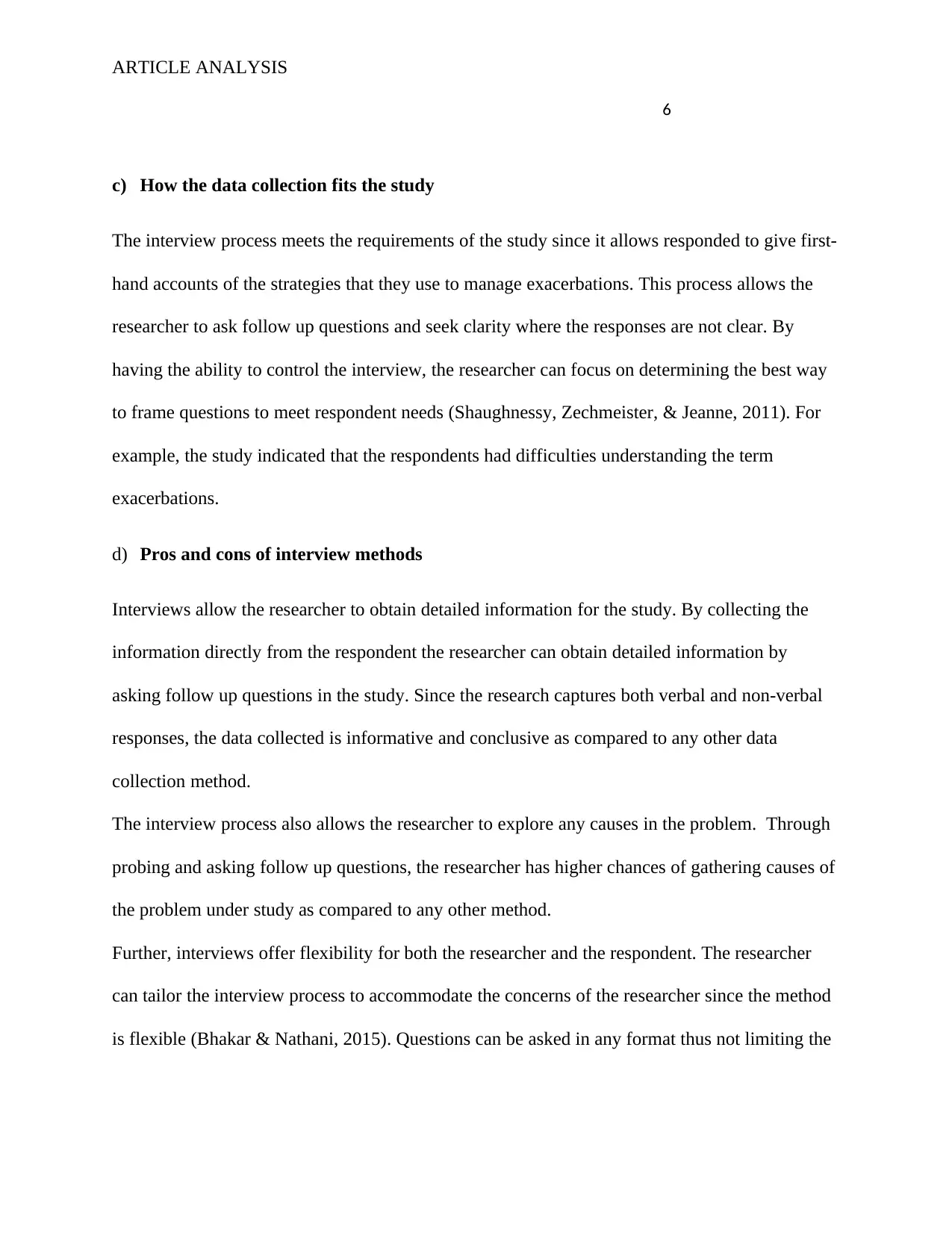
ARTICLE ANALYSIS
6
c) How the data collection fits the study
The interview process meets the requirements of the study since it allows responded to give first-
hand accounts of the strategies that they use to manage exacerbations. This process allows the
researcher to ask follow up questions and seek clarity where the responses are not clear. By
having the ability to control the interview, the researcher can focus on determining the best way
to frame questions to meet respondent needs (Shaughnessy, Zechmeister, & Jeanne, 2011). For
example, the study indicated that the respondents had difficulties understanding the term
exacerbations.
d) Pros and cons of interview methods
Interviews allow the researcher to obtain detailed information for the study. By collecting the
information directly from the respondent the researcher can obtain detailed information by
asking follow up questions in the study. Since the research captures both verbal and non-verbal
responses, the data collected is informative and conclusive as compared to any other data
collection method.
The interview process also allows the researcher to explore any causes in the problem. Through
probing and asking follow up questions, the researcher has higher chances of gathering causes of
the problem under study as compared to any other method.
Further, interviews offer flexibility for both the researcher and the respondent. The researcher
can tailor the interview process to accommodate the concerns of the researcher since the method
is flexible (Bhakar & Nathani, 2015). Questions can be asked in any format thus not limiting the
6
c) How the data collection fits the study
The interview process meets the requirements of the study since it allows responded to give first-
hand accounts of the strategies that they use to manage exacerbations. This process allows the
researcher to ask follow up questions and seek clarity where the responses are not clear. By
having the ability to control the interview, the researcher can focus on determining the best way
to frame questions to meet respondent needs (Shaughnessy, Zechmeister, & Jeanne, 2011). For
example, the study indicated that the respondents had difficulties understanding the term
exacerbations.
d) Pros and cons of interview methods
Interviews allow the researcher to obtain detailed information for the study. By collecting the
information directly from the respondent the researcher can obtain detailed information by
asking follow up questions in the study. Since the research captures both verbal and non-verbal
responses, the data collected is informative and conclusive as compared to any other data
collection method.
The interview process also allows the researcher to explore any causes in the problem. Through
probing and asking follow up questions, the researcher has higher chances of gathering causes of
the problem under study as compared to any other method.
Further, interviews offer flexibility for both the researcher and the respondent. The researcher
can tailor the interview process to accommodate the concerns of the researcher since the method
is flexible (Bhakar & Nathani, 2015). Questions can be asked in any format thus not limiting the
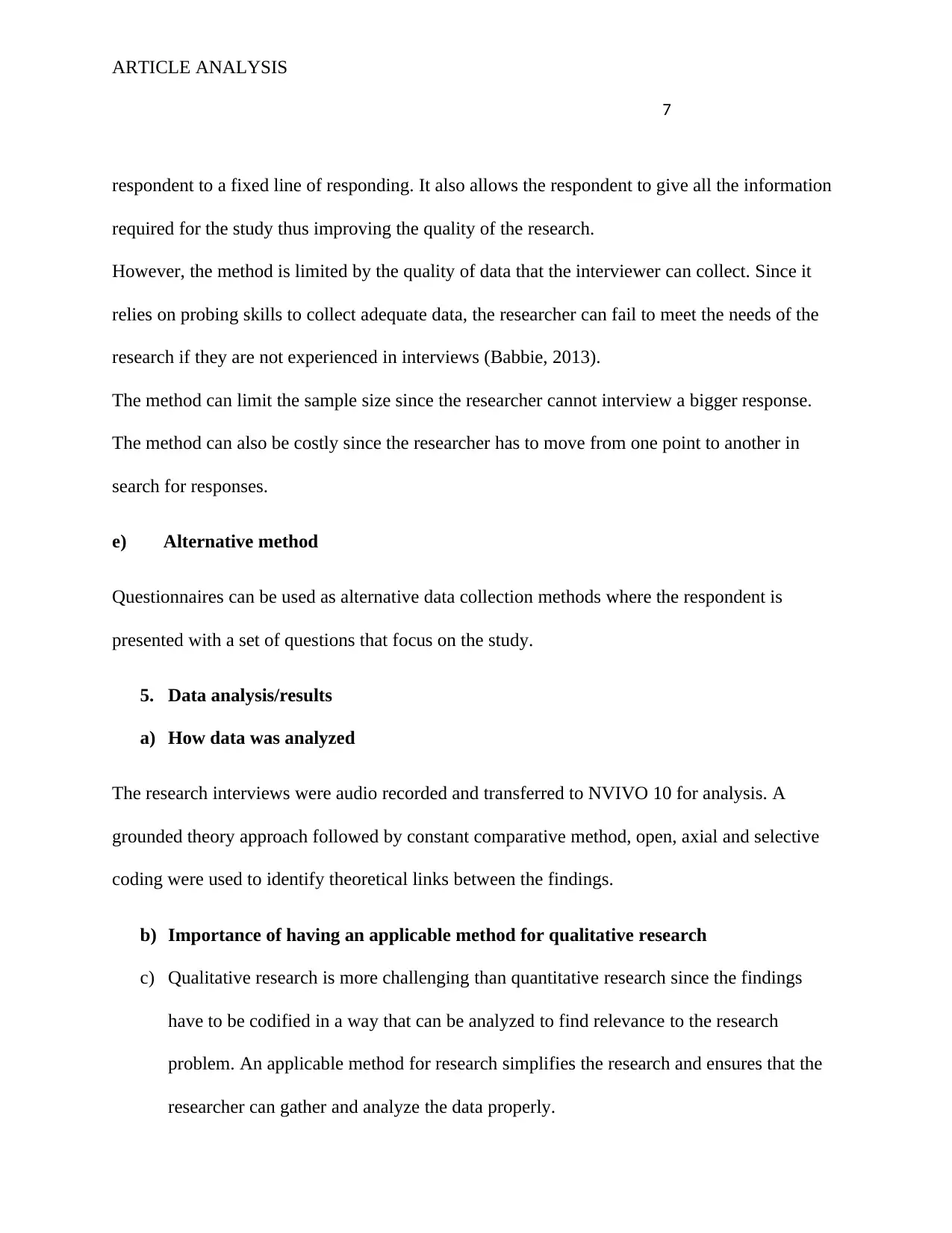
ARTICLE ANALYSIS
7
respondent to a fixed line of responding. It also allows the respondent to give all the information
required for the study thus improving the quality of the research.
However, the method is limited by the quality of data that the interviewer can collect. Since it
relies on probing skills to collect adequate data, the researcher can fail to meet the needs of the
research if they are not experienced in interviews (Babbie, 2013).
The method can limit the sample size since the researcher cannot interview a bigger response.
The method can also be costly since the researcher has to move from one point to another in
search for responses.
e) Alternative method
Questionnaires can be used as alternative data collection methods where the respondent is
presented with a set of questions that focus on the study.
5. Data analysis/results
a) How data was analyzed
The research interviews were audio recorded and transferred to NVIVO 10 for analysis. A
grounded theory approach followed by constant comparative method, open, axial and selective
coding were used to identify theoretical links between the findings.
b) Importance of having an applicable method for qualitative research
c) Qualitative research is more challenging than quantitative research since the findings
have to be codified in a way that can be analyzed to find relevance to the research
problem. An applicable method for research simplifies the research and ensures that the
researcher can gather and analyze the data properly.
7
respondent to a fixed line of responding. It also allows the respondent to give all the information
required for the study thus improving the quality of the research.
However, the method is limited by the quality of data that the interviewer can collect. Since it
relies on probing skills to collect adequate data, the researcher can fail to meet the needs of the
research if they are not experienced in interviews (Babbie, 2013).
The method can limit the sample size since the researcher cannot interview a bigger response.
The method can also be costly since the researcher has to move from one point to another in
search for responses.
e) Alternative method
Questionnaires can be used as alternative data collection methods where the respondent is
presented with a set of questions that focus on the study.
5. Data analysis/results
a) How data was analyzed
The research interviews were audio recorded and transferred to NVIVO 10 for analysis. A
grounded theory approach followed by constant comparative method, open, axial and selective
coding were used to identify theoretical links between the findings.
b) Importance of having an applicable method for qualitative research
c) Qualitative research is more challenging than quantitative research since the findings
have to be codified in a way that can be analyzed to find relevance to the research
problem. An applicable method for research simplifies the research and ensures that the
researcher can gather and analyze the data properly.
Paraphrase This Document
Need a fresh take? Get an instant paraphrase of this document with our AI Paraphraser
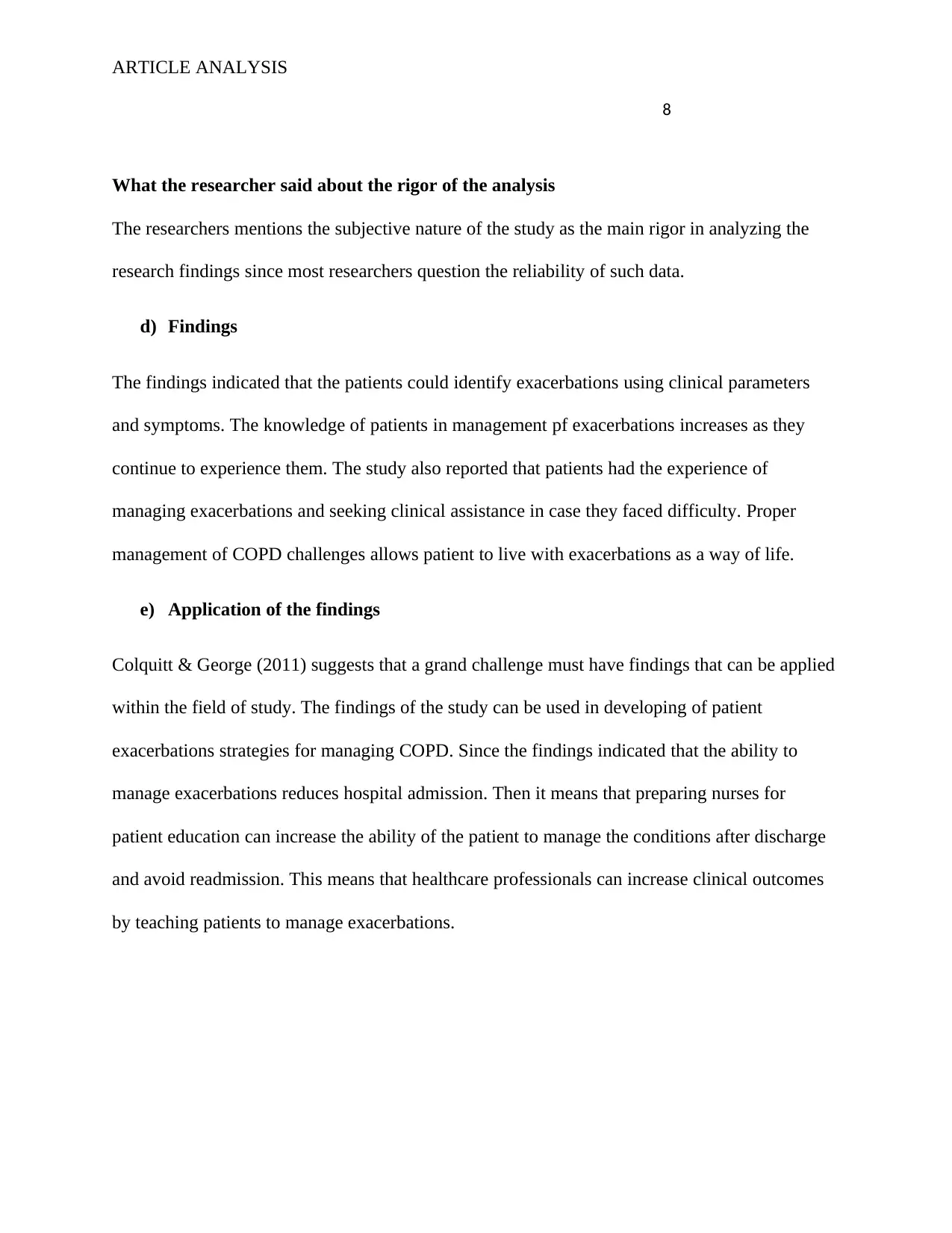
ARTICLE ANALYSIS
8
What the researcher said about the rigor of the analysis
The researchers mentions the subjective nature of the study as the main rigor in analyzing the
research findings since most researchers question the reliability of such data.
d) Findings
The findings indicated that the patients could identify exacerbations using clinical parameters
and symptoms. The knowledge of patients in management pf exacerbations increases as they
continue to experience them. The study also reported that patients had the experience of
managing exacerbations and seeking clinical assistance in case they faced difficulty. Proper
management of COPD challenges allows patient to live with exacerbations as a way of life.
e) Application of the findings
Colquitt & George (2011) suggests that a grand challenge must have findings that can be applied
within the field of study. The findings of the study can be used in developing of patient
exacerbations strategies for managing COPD. Since the findings indicated that the ability to
manage exacerbations reduces hospital admission. Then it means that preparing nurses for
patient education can increase the ability of the patient to manage the conditions after discharge
and avoid readmission. This means that healthcare professionals can increase clinical outcomes
by teaching patients to manage exacerbations.
8
What the researcher said about the rigor of the analysis
The researchers mentions the subjective nature of the study as the main rigor in analyzing the
research findings since most researchers question the reliability of such data.
d) Findings
The findings indicated that the patients could identify exacerbations using clinical parameters
and symptoms. The knowledge of patients in management pf exacerbations increases as they
continue to experience them. The study also reported that patients had the experience of
managing exacerbations and seeking clinical assistance in case they faced difficulty. Proper
management of COPD challenges allows patient to live with exacerbations as a way of life.
e) Application of the findings
Colquitt & George (2011) suggests that a grand challenge must have findings that can be applied
within the field of study. The findings of the study can be used in developing of patient
exacerbations strategies for managing COPD. Since the findings indicated that the ability to
manage exacerbations reduces hospital admission. Then it means that preparing nurses for
patient education can increase the ability of the patient to manage the conditions after discharge
and avoid readmission. This means that healthcare professionals can increase clinical outcomes
by teaching patients to manage exacerbations.
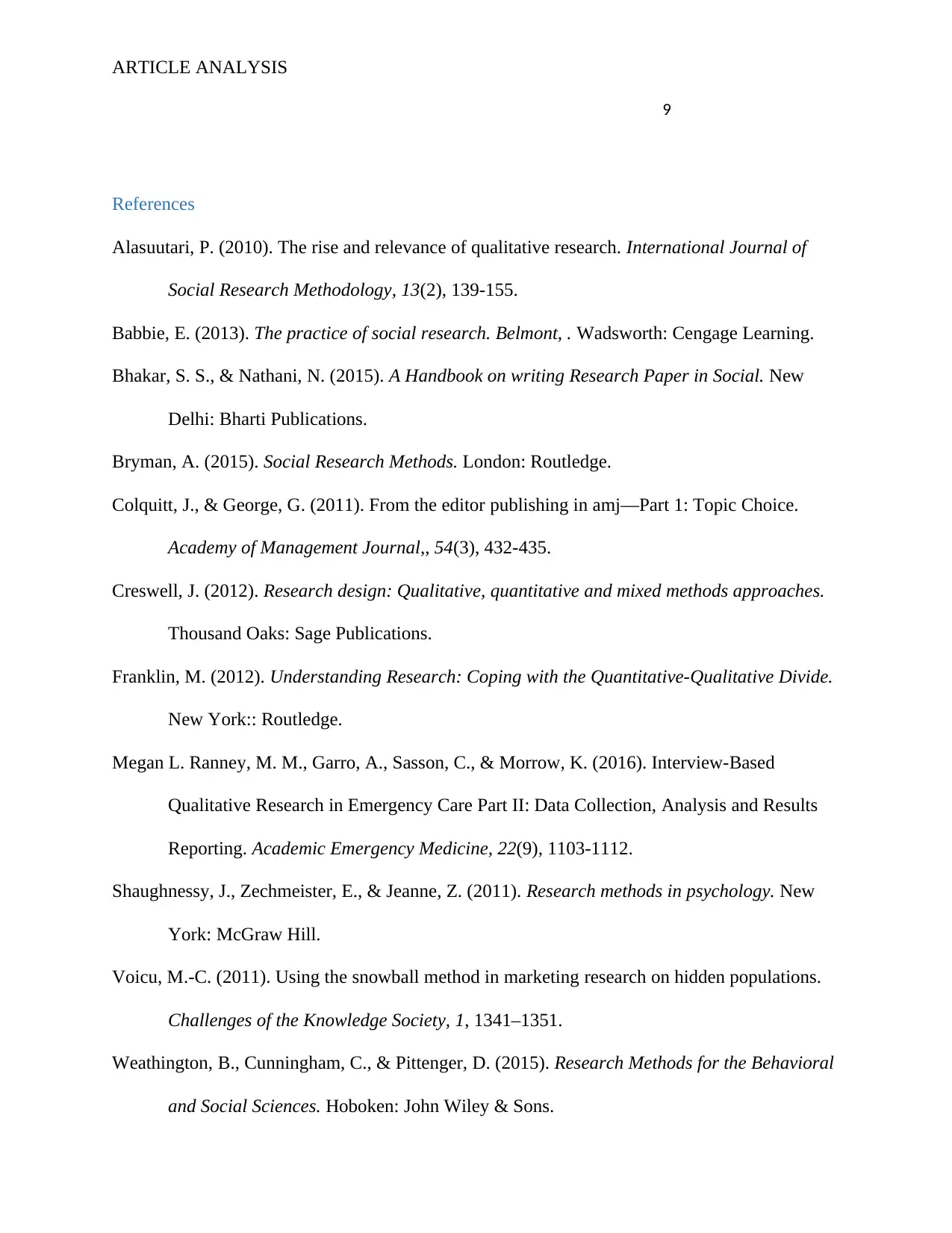
ARTICLE ANALYSIS
9
References
Alasuutari, P. (2010). The rise and relevance of qualitative research. International Journal of
Social Research Methodology, 13(2), 139-155.
Babbie, E. (2013). The practice of social research. Belmont, . Wadsworth: Cengage Learning.
Bhakar, S. S., & Nathani, N. (2015). A Handbook on writing Research Paper in Social. New
Delhi: Bharti Publications.
Bryman, A. (2015). Social Research Methods. London: Routledge.
Colquitt, J., & George, G. (2011). From the editor publishing in amj—Part 1: Topic Choice.
Academy of Management Journal,, 54(3), 432-435.
Creswell, J. (2012). Research design: Qualitative, quantitative and mixed methods approaches.
Thousand Oaks: Sage Publications.
Franklin, M. (2012). Understanding Research: Coping with the Quantitative-Qualitative Divide.
New York:: Routledge.
Megan L. Ranney, M. M., Garro, A., Sasson, C., & Morrow, K. (2016). Interview-Based
Qualitative Research in Emergency Care Part II: Data Collection, Analysis and Results
Reporting. Academic Emergency Medicine, 22(9), 1103-1112.
Shaughnessy, J., Zechmeister, E., & Jeanne, Z. (2011). Research methods in psychology. New
York: McGraw Hill.
Voicu, M.-C. (2011). Using the snowball method in marketing research on hidden populations.
Challenges of the Knowledge Society, 1, 1341–1351.
Weathington, B., Cunningham, C., & Pittenger, D. (2015). Research Methods for the Behavioral
and Social Sciences. Hoboken: John Wiley & Sons.
9
References
Alasuutari, P. (2010). The rise and relevance of qualitative research. International Journal of
Social Research Methodology, 13(2), 139-155.
Babbie, E. (2013). The practice of social research. Belmont, . Wadsworth: Cengage Learning.
Bhakar, S. S., & Nathani, N. (2015). A Handbook on writing Research Paper in Social. New
Delhi: Bharti Publications.
Bryman, A. (2015). Social Research Methods. London: Routledge.
Colquitt, J., & George, G. (2011). From the editor publishing in amj—Part 1: Topic Choice.
Academy of Management Journal,, 54(3), 432-435.
Creswell, J. (2012). Research design: Qualitative, quantitative and mixed methods approaches.
Thousand Oaks: Sage Publications.
Franklin, M. (2012). Understanding Research: Coping with the Quantitative-Qualitative Divide.
New York:: Routledge.
Megan L. Ranney, M. M., Garro, A., Sasson, C., & Morrow, K. (2016). Interview-Based
Qualitative Research in Emergency Care Part II: Data Collection, Analysis and Results
Reporting. Academic Emergency Medicine, 22(9), 1103-1112.
Shaughnessy, J., Zechmeister, E., & Jeanne, Z. (2011). Research methods in psychology. New
York: McGraw Hill.
Voicu, M.-C. (2011). Using the snowball method in marketing research on hidden populations.
Challenges of the Knowledge Society, 1, 1341–1351.
Weathington, B., Cunningham, C., & Pittenger, D. (2015). Research Methods for the Behavioral
and Social Sciences. Hoboken: John Wiley & Sons.

ARTICLE ANALYSIS
10
Williams, V., Hardinge, M., Ryan, S., & Farmer, A. (2014). Patients’ experience of identifying
and managing exacerbations in COPD: a qualitative study. Primary Care Respiratory
Society,, 1-6.
10
Williams, V., Hardinge, M., Ryan, S., & Farmer, A. (2014). Patients’ experience of identifying
and managing exacerbations in COPD: a qualitative study. Primary Care Respiratory
Society,, 1-6.
1 out of 10
Related Documents
Your All-in-One AI-Powered Toolkit for Academic Success.
+13062052269
info@desklib.com
Available 24*7 on WhatsApp / Email
![[object Object]](/_next/static/media/star-bottom.7253800d.svg)
Unlock your academic potential
© 2024 | Zucol Services PVT LTD | All rights reserved.




